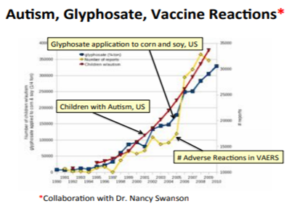This is blog 3 of a 4 part series on glyphosate. In the blog 8 Ways Glyphosate Derails Our Health – Part 1.
Here we discussed: Glyphosate as a Gut Microbiome Disruptor and as an Enzyme Disruptor. Let’s continue. Grab a cup of tea because we are going deep!
3. As a Trace Mineral Disruptor.
As you know the body needs essential vitamins and minerals. There are 7 macro minerals and 13 trace minerals that make up the 20 essential “minerals” list. Manganese is an example of a trace mineral. Now do not be fooled into thinking these trace minerals are nice-to-haves. Just because they are required in small amounts, does not trivialize the body’s mandatory requirements for them.
Glyphosate’s disruption of the shikimate pathway is due in part to its chelation (binding to) of Manganese (Mn). This trace mineral is a catalyst for the enolpyruvyl shikimate phosphate synthase (EPSPS), a critical early enzyme in the pathway that we mentioned earlier.
Glyphosate, the active ingredient in Roundup has also been shown to severely deplete Mn levels in plants. A recent study on Danish dairy cattle investigated mineral composition in serum of cattle fed Roundup-Ready feed. The study identified a marked deficiency in two minerals: Serum cobalt and serum Mn. All the cattle on eight different farms had severe Mn deficiency, along with measurable amounts of glyphosate in their urine.1
 In Australia, following two seasons of high levels of stillbirths in cattle, it was found that all dead calves were Mn deficient.2 Furthermore, 63% of newborns with birth defects were found to be deficient in Mn.1
In Australia, following two seasons of high levels of stillbirths in cattle, it was found that all dead calves were Mn deficient.2 Furthermore, 63% of newborns with birth defects were found to be deficient in Mn.1
Manganese (Mn), named after the Greek word for “magic,” is as we have said one of 14 essential trace elements. Mn among other things plays essential roles in:1
- antioxidant protection,
- glutamine synthesis,
- bone development,
- sperm motility,
Although Mn is essential, it is only required in trace amounts. And an excess of Mn can be neurotoxic.3
Let us look at how glyphosate impacts Mn and its association with gut dysbiosis as well as neuropathologies such as autism, Alzheimer’s disease (AD), depression, anxiety syndrome, Parkinson’s disease (PD), and prion diseases. It’s pretty fascinating.
Autism, Alzheimer’s disease (AD), depression, anxiety syndrome, Parkinson’s disease (PD), and prion diseases are neurological disorders associated with mitochondrial impairment and with excess glutamate and ammonia in the brain, which lead to a chronic low-grade encephalopathy (inflammation).
Studies show1:
- Mn superoxide dismutase protects mitochondria from oxidative damage, and mitochondrial dysfunction is a key feature of autism and Alzheimer’s. And heck a vast number of modern-day illnesses!
- Glutamate overexpression in the brain in association with autism, Alzheimer’s disease (AD), and other neurological diseases can be explained by Mn deficiency.
- Mn deficiency can lead to a reduction in Lactobacillus in the gut, and this is linked to anxiety disorder.
- Lactobacillus, depleted in autism, depend critically on Mn for antioxidant protection. Lactobacillus probiotics can treat anxiety, which is a comorbidity of autism and chronic fatigue syndrome. Reduced gut Lactobacillus leads to an overgrowth of the pathogen, Salmonella, which is resistant to glyphosate toxicity, and Mn plays a role here as well.
- Under conditions of adequate Mn in the diet, glyphosate, through its disruption of bile acid homeostasis, ironically promotes toxic accumulation of Mn in the brainstem, leading to conditions such as Parkinson’s Disease and prion diseases (neurodegenerative diseases).
How this works is that glyphosate disrupts CYP enzymes and the liver, instead of disposing of Mn through bile acids, it transports it via the Vagus nerve to brainstem nuclei.
We must appreciate that both Mn deficiency and Mn toxicity, attributable to glyphosate, can occur simultaneously.
How can this be?
When the brainstem suffers from excess Mn, the rest of the brain sees Mn deficiency because of the lower levels of serum Mn. This is also worrying because then the toxic chemicals in the Roundup can enter our brain, where they can then push heavy metals and other chemicals through the blood-brain barrier.4
Let me repeat that.
When the brainstem suffers from excess Mn, the rest of the brain sees Mn deficiency because of the lower levels of serum Mn. This is also worrying because then the toxic chemicals in the Roundup can enter our brain, where they can then push heavy metals and other chemicals through the blood-brain barrier.
Ironically, while the brainstem suffers from excess Mn, the rest of the brain incurs Mn deficiency due to the depressed serum levels of Mn. Manganese is particularly important in the hippocampus, and deficiency there can lead to seizures.
 A high incidence of seizures is found in children with autism. Seizures are also associated with reduced serum Mn, and this is consistent with the liver’s inability to distribute Mn to the body via the bile acids due to the presence of glyphosate.5 Antibiotics have been found to induce seizures and when we appreciate the precipitating factors here, this makes sense.6
A high incidence of seizures is found in children with autism. Seizures are also associated with reduced serum Mn, and this is consistent with the liver’s inability to distribute Mn to the body via the bile acids due to the presence of glyphosate.5 Antibiotics have been found to induce seizures and when we appreciate the precipitating factors here, this makes sense.6
Mn uptake in the brain is normally enhanced during the neonatal period in rats, and proper development of the hippocampus depends on Mn. Soy formula increases the risk of seizures in autism, hardly surprising when one considers that soybean crops are now 90% Roundup-Ready. A recent paper has confirmed that alarmingly high glyphosate residues appear in Roundup-Ready soy.7
Other effects of Mn deficiency
Furthermore, increases in bone fractures in both children and the elderly can also be explained by Mn deficiency, due to its critical role in bone development. Osteoporosis, which is a serious problem among the elderly today, is also likely promoted by Mn deficiency, and osteoporosis leads to an increased risk of fractures.
4. As a Mineral Chelator
Glyphosate potentially contributes to mineral deficiencies. Glyphosate chelates (binds to) minerals like copper, manganese, cobalt, iron, zinc, calcium, and magnesium, which could prevent proper absorption and utilization of these minerals in the body.8 Nearly one-third of American adults and children are already at risk for at least one nutrient deficiency (and let’s be clear these stats look similar around the Western world), and many of these minerals are enzymatic cofactors for normal cellular functions.9
With a zinc (Zn) depletion for example we see DNA and RNA replication and cell division being disrupted. Without enough Zn, cells take up excessive amounts of Manganese (Mn) which then makes modifications to our mRNA (which are an RNA version of genes that are needed to make specific proteins) and in turn has adverse ramifications on our DNA.
 Zinc deficiency is a major problem worldwide, particularly in the developing world, where limited access to zinc-rich foods such as shellfish and excess dietary exposure to phytates both contribute to the problem10. Phytates, found in many nuts and grains, bind to dietary minerals and interfere with the absorption of vitamins and minerals.
Zinc deficiency is a major problem worldwide, particularly in the developing world, where limited access to zinc-rich foods such as shellfish and excess dietary exposure to phytates both contribute to the problem10. Phytates, found in many nuts and grains, bind to dietary minerals and interfere with the absorption of vitamins and minerals.
Lactobacilli and other beneficial gut bacteria produce the enzyme phytase, which catalyses the release of phosphate from phytates and improves the intestinal absorption of important minerals such as iron and zinc.11 Because glyphosate reduces the number of these types of bacteria in the gut, it enhances the chelating potential of phytates. Making absorption harder again.
Stay with me now.
Zinc is the most abundant trace metal in the brain. Zinc deficiency leads to plaque builds up in the brain as we see with Alzheimer’s disease. Studies show that zinc deficiency is implicated in autism and ADHD12. Zinc is released into the synapse along with the neurotransmitter glutamate, and it is required for memory function and the maintenance of synaptic health as we age.
Folate deficiency (Vitamin B9): Folate is made by lactobacillus and bifidobacteria, which rely on the shikimate pathway. Without sufficient folate to make and repair DNA and red blood cells, we can expect conditions such as high serum homocysteine, anaemia, persistent fatigue, and even birth defects if pregnant.1
Such damage to red blood cells can also lead to anaemia and toxicity due to free iron3 or hypoxia (low oxygen levels in your tissues)
5. As an Inhibitor of Amino Acids
When Roundup kills beneficial gut bacteria, it makes room for pathogens to thrive and interferes with Amino Acids (AA) synthesis. We discussed this briefly before here’s a few specific examples.
Tryptophan deficiency arises when this amino acid is not synthesised properly when the gut bacteria is not fully functioning. Tryptophan is the sole precursor to serotonin and melatonin and has appetite-suppressing qualities. With insufficient tryptophan, irrational aggressive behaviour, anxiety, and depression, as well as sleep deficiency and overeating, can be attributed to the effect of glyphosate on our gut bacteria.
Melatonin is impacted. Tryptophan deficiency may also impact the levels of melatonin we have in our bodies. Melatonin BINDS to aluminium, cadmium, copper, iron and leads to reduce their toxicity, (without melatonin, it makes the body much more toxic as well as unable to regulate the sleep/wake cycle). This makes sense when we consider poor gut health and metal toxicity of many spectrum disorders.
Methionine may also become offset. With the body weak and depleted of AAs, shortages of critical neurotransmitters, and folate deficiency may affect the neural tube and impair the methylation pathway in a vicious cycle1. These pathways are all identified with autism and AD. Make sure you have a read of our series of methylation blogs.
6. As an Endocrine Disruptor
Since glyphosate damages, CYP enzymes research suggests that glyphosate herbicides may act as endocrine disruptors, chemicals that interfere with the body’s normal hormone signaling pathways. Endocrine disruptors are insidious; they wreak havoc overtime at very low levels, in contrast to acute toxicity studies performed at high levels of exposure.
Cell experiments have shown that glyphosate-based herbicides interfered with estrogen and androgen receptors and also with aromatase, the enzyme that converts testosterone into estrogen.13, 14, 15 Glyphosate was also shown to induce human breast cancer cell proliferation via estrogen receptors.16
7. As an Oxidative Stressor
Rodents drinking glyphosate dissolved in water at the “highest allowable” level for three months had increased lipid peroxidation and glutathione peroxidase, both indicators of oxidative stress.17, 18 Other in vivo and in vitro studies have also shown that glyphosate induces oxidative stress.19 -21


This is also interesting. As celiac disease induces a state of chronic inflammation, this results in oxidative stress, which in turn causes DNA damage and an increased risk of genetic mutations due to impaired repair mechanisms. Over time, these genetic mutations, along with alterations in DNA methylation status, can cause a cell to revert to an immortal stem-cell-like phenotype called a “cancer stem cell.” These cells become more mobile and are obsessed with cloning themselves endlessly, leading to tumor growth and metastasis. Non-Hodgkin’s lymphoma tumor cells emerge out of an original population of B cells in the immune system.36
8. As a Fertility Blocker
And yes, you guessed it – glyphosate certainly seems to have played a role in the rapid decline in male fertility over the last few decades. Sperm motility depends heavily on Mn, and this may partially explain increased rates of infertility and birth defects.
The rationale lies with the knowledge that sperm relies on an enzyme called aromatase (as we mentioned earlier) to balance and synthesize sex hormones by converting testosterone to estrogen, as well as some functions in metabolism.
Studies suggest that glyphosate inhibits this process. A study on 60-day-old male rats exposed to Roundup showed that the chemical caused a significant increase of aromatase mRNA in testicular tissue5, which likely is indicative of the suppressed activity of aromatase (CYP19) as well as abnormal sperm morphology25.


This is an interesting extract from the paper “Glyphosate’s Suppression of Cytochrome P450 Enzymes and Amino Acid Biosynthesis by the Gut Microbiome”27:
“Cholesterol sulfate plays an essential role in fertilization and zinc is essential to the male reproductive system, with a high concentration found in semen. Thus, the likely reduction in the bioavailability of these two nutrients due to the effects of glyphosate could be contributory to infertility problems. Furthermore, glyphosate’s suppression of CYP protein activity would be expected to disrupt steroidogenesis.
“Inflammation leads to excess ROS and RNS exposure, which can damage DNA during cell replication, thus disrupting embryonic development.”
So it appears that glyphosate not only damages sperm function but the inflammatory response contributes to problems with DNA replication and additionally embryonic development. Couples often think that miscarriage is a female reproductive issue, however, the harmful effects of glyphosate demonstrate how toxins play a substantial role in fertility outcomes.
Back to inflammation. Preeclampsia is on the rise in America, and it has been proposed that it too may be due to impaired sulfate supply28, directly attributable to glyphosate exposure. Glyphosate can cross the placental barrier29 which is not surprising as we have already discussed it passes through the blood-brain barrier. Pre-eclampsia, a life-threatening condition for both the mother and the fetus that develops during the third trimester, early signs, include high blood pressure (hypertension) and protein in the urine (proteinuria).
Preeclampsia is the most common complication to occur during pregnancy. Later on, blurry vision, shortness of breath, vomiting, decrease in urine output, decrease in platelets in the blood, impaired liver function, and other symptoms may arise. If the preeclampsia remains untreated, it can develop into eclampsia, in which the mother can experience convulsions, coma, and can even die. Researchers suggest that this condition may arise due to impaired sulfate supply, directly attributable to glyphosate exposure.28



A steady increase in the rate of preterm births in Brazil over the past two decades has been noted, although the cause remains elusive. For instance, the rate increased from 6% in 1982 to 15% in 2004 in the town of Pelotas31. It is conceivable that increased exposure to glyphosate is contributing to this problem. This idea is in line with a study of an Ontario farm population, which revealed that glyphosate exposure any time during pregnancy was associated with a statistically significant increased risk of a late-pregnancy spontaneous abortion32.
The birth rates in Western Europe have also been declining for decades, with Germany’s rate now being 1.36 children per woman. Birth rates have also been declining in the U.S since 2007, and are now at 1.9 children per woman, according to the 2011 government statistics33.
In the in vitro effects of several different pesticides and herbicides on the synthesis of progesterone in testicular Leydig cells were investigated. 34 Comparing eight different pesticides (Ammo®, Banvel®, Cotoran®, Cyclone®, Dual®, Fusilade® and Roundup®), it was found that, among these eight, Roundup® uniquely disrupted the cells’ ability to produce progesterone, reducing synthesis levels by up to 94% in a dose-dependent manner, without reducing total protein synthesis.
Okay to wrap up the ill-effects of glyphosate, lets go back over some of the fine print that we’ve discussed.
SUMMARY
Glyphosate is the most widely used herbicide on the planet, in part because of its perceived low toxicity to humans. We suggest that glyphosate’s chelation (binding and removal) of Manganese (Mn), culminates together with other damaging known effects of glyphosate such as:
- CYP enzyme suppression
- depletion of derivatives of the shikimate pathway in microorganisms
Together this process may explain the recent increase in the incidence of multiple neurological diseases and other pathologies. We have shown that glyphosate’s disruption of Mn homeostasis can lead to extreme sensitivity to variations in Mn bioavailability.
- Mn deficiency in the blood leads to impairment of several Mn dependent enzymes, in contrast, excess Mn readily accumulates in the liver and in the brainstem due to the liver’s impaired ability to export it in the bile acids. This pathology can lead to liver damage and Parkinson’s Disease.
- Mn depletion in the gut due to chelation by glyphosate selectively affects Lactobacillus, leading to increased anxiety via the gut-brain access. Both low Lactobacillus levels in the gut and anxiety syndrome are known features of autism.
- Low Mn bioavailability from the blood supply to the brain leads to impaired function of glutamine synthase and a build-up of glutamate and ammonia in the brain, both of which are neurotoxic. Excess brain glutamate and ammonia are associated with many neurological diseases.
- At the same time, impaired function of Mn-SOD in the mitochondria results in mitochondrial damage, also a hallmark of many neurological diseases.
- Mn deficiency can account for poor sperm motility and therefore low fertilization rates.
- Mn deficiency can account for poor bone development leading to osteoporosis and osteomalacia.
Other ways glyphosate impacts the body aside from influencing Manganese:
- Causes extreme disruption to the gut microbes’ functions and lifecycles.
- Disrupting the shikimate pathway in our gut bacteria. Studies show that pathogenic strains of gut bacteria, like Salmonella and Clostridium, were resistant to glyphosate exposure, while glyphosate attacked beneficial strains like Enterococcus, Bacillus, and Lactobacillus.
- This disruption causes a leaky gut resulting in inflammatory bowel diseases. Glyphosate allows toxins through the blood-brain barrier. A leaky gut and a leaky blood-brain barrier led to dangerous exposure to neurotoxins and metals in the brain.
- Chelates (binds to) minerals like copper, manganese, cobalt, iron, zinc, calcium, and magnesium, which could prevent proper absorption and utilization of these minerals in the body.
- Inhibits amino acids like Tryptophan which is the sole precursor to serotonin and melatonin and has appetite-suppressing qualities. With insufficient tryptophan, irrational aggressive behaviour, anxiety, and depression, as well as sleep deficiency and overeating, can be attributed to the effect of glyphosate on our gut bacteria.
- Tryptophan deficiency may also impact the levels of melatonin we have in our bodies. Melatonin binds to aluminium, cadmium, copper, iron and leads to reduce their toxicity, (without melatonin, it makes the body much more toxic as well as unable to regulate the sleep/wake cycle). This makes sense when we consider poor gut health and metal toxicity of many spectrum disorders.
- Methionine may become offset. With the body weak and depleted of AAs, shortages of critical neurotransmitters, and folate deficiency may affect the neural tube and impair the methylation pathway in a vicious cycle.
Many diseases and conditions are currently on the rise in step with glyphosate usage in agriculture, particularly on GM crops of corn and soy. These include autism, AD, PD, anxiety disorder, osteoporosis, inflammatory bowel disease, renal lithiasis, osteomalacia, cholestasis, thyroid dysfunction, and infertility. Through destroying gut bacteria sets in motion two key problems:
- Nutritional deficiencies (especially minerals and essential amino acids)
- Systemic toxicity
We hope that we have demonstrated that there is now a growing body of research that provides credible physiological explanations on how glyphosate impacts the human body and how it has become a gateway for modern disease.
According to Dr. Zach Bush (an internationally recognized thought leader on the microbiome), the repercussions of glyphosate on past and future generations is catastrophic. In a tri-generational study on mice, it was seen that if the first generation was exposed to Roundup, the second generation does not even have to be exposed to the chemical to then suffer from a multitude of diseases, immune dysfunction, and shortened lifespan8.
The situation, unfortunately, does not improve for the third generation, where the mice develop cancers and had stillbirths still without even being exposed to Roundup themselves8. These cumulative epigenetic effects lead to a rough estimation of Bush’s that the human race could be all but extinct because of the autoimmune diseases present in children, fertility rates dropping, autism, and even his prediction that we will run out of topsoil within the next 60 years.
Fortunately, there are some solutions for ridding our bodies of as much glyphosate as possible and keeping it out of us as well. We will discuss these in our fourth blog “Addressing Glyphosate in your Body”.
Yours in Health
Jennifer Barham-Floreani,
Bach. Chiropractic, Bach. App Clinical Science
Registered internationally, no longer practicing as a chiropractor in Australia.
Isobella Doherty,
Research Assistant and Student
Barcelona College of Chiropractic
References:
1 Seneff S, Samsel A. Glyphosate, pathways to modern diseases III: Manganese, neurological diseases, and associated pathologies. Surgical Neurology International. 2015;6(1):45.
2. McLaren PJ, Cave JG, Parker EM, Slocombe RF. Chondrodysplastic calves in Northeast Victoria. Vet Pathol. 2007; 44:342–54.
3. Cattani D, de Liz Oliveira Cavalli VL, Heinz Rieg CE, Domingues JT, Dal-Cim T, Tasca CI, et al.Mechanisms underlying the neurotoxicity induced by glyphosate-based herbicide in immature rat hippocampus: Involvement of glutamate excitotoxicity. Toxicology. 2014; 320C
4. Wennberg RP. The blood-brain barrier and bilirubin encephalopathy. Cell Mol Neurobiol. 2000;20:97–109.
5. Ito Y, Ishige K, Aizawa M, Fukuda H. Characterization of quinolone antibacterial-induced convulsions and increases in nuclear AP-1 DNA- and CRE-binding activities in mouse brain. Neuropharmacology. 1999; 38:717–23.
6. Sohler A, Pfeiffer CC. A direct method for the determination of manganese in whole blood. Patients with seizure activity have low blood levels. J Orthomol Psych. 1979; 8
7. Bøhn T, Cuhra M, Traavik T, Sanden M, Fagan J, Primicerio R. Compositional differences in soybeans on the market: Glyphosate accumulates in Roundup Ready GM soybeans. Food Chem. 2014; 153:207–15.
8. Samsel A, Seneff S. Glyphosate, pathways to modern diseases II: Celiac sprue and gluten intolerance. Interdiscip Toxicol. 2013 Dec;6(4):159-84. doi: 10.2478/intox-2013-0026. PMID: 24678255; PMCID: PMC3945755.
9. Bird JK, Murphy RA, Ciappio ED, McBurney MI. Risk of Deficiency in Multiple Concurrent Micronutrients in Children and Adults in the United States.Nutrients. 2017;9(7):655. Published 2017 Jun 24. doi:10.3390/nu9070655
10. Watt, N.T.; Whitehouse, I.J.; Hooper, N.M. The role of zinc in Alzheimer’s disease. Int. J. Alz. Dis. 2011, 2011, 971021.
11. Yasuda, H.; Yoshida, K.; Yasuda, Y.; Tsutsui, T. Infantile zinc deficiency: Association with autism spectrum disorders.Scientific Reports2011, 1, 129
12. Akhondzadeh, S.; Mohammadi, M.R.; Khademi, M. Zinc sulfate as an adjunct to methylphenidate for the treatment of attention deficit hyperactivity disorder in children: a double-blind and randomised trial. BMC Psychiatr. 2004, 4, 9.
13. Richard S, Moslemi S, Sipahutar H, Benachour N, Seralini GE. Differential effects of glyphosate and roundup on human placental cells and aromatase. Environ Health Perspect. 2005 Jun;113(6):716-20. doi: 10.1289/ehp.7728. PMID: 15929894; PMCID: PMC1257596.
14. Gasnier C, Dumont C, Benachour N, Clair E, Chagnon MC, Séralini GE. Glyphosate-based herbicides are toxic and endocrine disruptors in human cell lines. Toxicology. 2009 Aug 21;262(3):184-91. doi: 10.1016/j.tox.2009.06.006. Epub 2009 Jun 17. PMID: 19539684.
15. Romano MA, Romano RM, Santos LD, Wisniewski P, Campos DA, de Souza PB, Viau P, Bernardi MM, Nunes MT, de Oliveira CA. Glyphosate impairs male offspring’s reproductive development by disrupting gonadotropin expression. Arch Toxicol. 2012 Apr;86(4):663-73. doi: 10.1007/s00204-011-0788-9. Epub 2011 Nov 26. PMID: 22120950.
16. 39 Thongprakaisang S, Thiantanawat A, Rangkadilok N, Suriyo T, Satayavivad J. Glyphosate induces human breast cancer cells growth via estrogen receptors. Food Chem Toxicol. 2013 Sep; 59:129-36. doi: 10.1016/j.fct.2013.05.057. Epub 2013 Jun 10. PMID: 23756170.
17. Larsen K, Najle R, Lifschitz A, Virkel G. Effects of sub-lethal exposure of rats to the herbicide glyphosate in drinking water: glutathione transferase enzyme activities, levels of reduced glutathione and lipid peroxidation in liver, kidneys and small intestine. Environ Toxicol Pharmacol. 2012 Nov;34(3):811-8. doi: 10.1016/j.etap.2012.09.005. Epub 2012 Sep 18. PMID: 23044091.
18. Vera Lúcia de Liz Oliveira Cavalli, Roundup disrupts male reproductive functions by triggering calcium-mediated cell death in rat testis and Sertoli cells, Free Radical Biology and Medicine, Volume 65, 2013, Pages 335-346,
19. Milić M, Žunec S, Micek V, Kašuba V, Mikolić A, Lovaković BT, Semren TŽ, Pavičić I, Čermak AMM, Pizent A, Vrdoljak AL, Valencia-Quintana R, Sánchez-Alarcón J, Želježić D. Oxidative stress, cholinesterase activity, and DNA damage in the liver, whole blood, and plasma of Wistar rats following a 28-day exposure to glyphosate. Arh Hig Rada Toksikol. 2018 Jun 1;69(2):154-168. doi: 10.2478/aiht-2018-69-3114. PMID: 29990293.
20. Cattani D, Cesconetto PA, Tavares MK, Parisotto EB, De Oliveira PA, Rieg CEH, Leite MC, Prediger RDS, Wendt NC, Razzera G, Filho DW, Zamoner A. Developmental exposure to glyphosate-based herbicide and depressive-like behavior in adult offspring: Implication of glutamate excitotoxicity and oxidative stress. Toxicology. 2017 Jul 15; 387:67-80. doi: 10.1016/j.tox.2017.06.001. Epub 2017 Jun 13. PMID: 28627408.
21. Yang X, Li Y, Li Y, et al. Oxidative Stress-Mediated Atherosclerosis: Mechanisms and Therapies.Front Physiol. 2017; 8:600. Published 2017 Aug 23. doi:10.3389/fphys.2017.00600
22. Ullah Asmat, Khan Abad, Khan Ismail, Diabetes mellitus and oxidative stress—A concise review, Saudi Pharmaceutical Journal, Volume 24, Issue 5, 2016,
23. Ates 1, Fatma Meric Yilmaz 1, et al. The relationship between oxidative stress and autoimmunity in Hashimoto’s thyroiditis in European Journal of Endocrinology. Dec 2015
24. Shah, D., Mahajan, N., Sah, S. et al. Oxidative stress and its biomarkers in systemic lupus erythematosus. J Biomed Sci 21, 23 (2014).
25. Cassault-Meyer E, Gress S, Séralini GE, Galeraud-Denis I. An acute exposure to glyphosate-based herbicide alters aromatase levels in testis and sperm nuclear quality. Environ Toxicol Pharmacol 2014; 38:131-40
26. Lopes, F. M., Varela Junior, A. S., Corcini, C. D., da Silva, A. C., Guazzelli, V. G., Tavares, G., & da Rosa, C. E. (2014). Effect of glyphosate on the sperm quality of zebrafish Danio rerio. Aquatic toxicology (Amsterdam, Netherlands), 155, 322–326. https://doi.org/10.1016/j.aquatox.2014.07.006
27. Samsel, A.; Seneff, S. Glyphosate’s Suppression of Cytochrome P450 Enzymes and Amino Acid Biosynthesis by the Gut Microbiome: Pathways to Modern Diseases.Entropy2013, 15, 1416-1463.
28. Seneff, S.; Davidson, R.M.; Liu, J. Is cholesterol sulfate deficiency a common factor in preeclampsia, autism, and pernicious anemia?Entropy2012, 14, 2265–2290.
29. Mose, T.; Kjaerstad, M.B.; Mathiesen, L.; Nielsen, J.B.; Edelfors, S.; Knudsen, L.E. Placental passage of benzoic acid, caffeine, and glyphosate in anex vivohuman perfusion system. J. Toxicol. Environ. Health A 2008, 71, 984–991.
30. Cerdeira, A.L.; Gazziero, D.L.; Duke, S.O.; Matallo, M.B.; Spadotto, C.A. Review of potential environmental impacts of transgenic glyphosate-resistant soybean in Brazil.J. Environ. Sci. Health B2007, 42, 539–549.
31. Silveira, M.F.; Santos, I.S.; Barros, A.J.D.; Matijasevich, A.; Barros, F.C.; Victora, C.G. Increase in preterm births in Brazil: Review of population-based studies.Rev. Saúde. Pública.2008, 42, 1–7.
32. Arbuckle, T.E.; Lin, Z.; Mery, L.S. An exploratory analysis of the effect of pesticide exposure on the risk of spontaneous abortion in an Ontario farm population.Environ. Health Persp.2001, 109, 851–857.
33. Hamilton, B.E.; Martin, J.A.; Ventura, S.J. Births: Preliminary data for 2011. InNational Vital Statistics Reports; National Center for Health Statistics: Hyattsville, MD, USA, 2012; Volume 61.
34. Walsh, L.P.; McCormick, C.; Martin, C.; Stocco, D.M. Roundup inhibits steroidogenesis by disrupting steroidogenic acute regulatory (StAR) protein expression.Environ. Health Persp.2000, 108, 769–776.
35. Bush Z. Regenerative Agriculture Podcast: Embracing the Connection Between Agriculture and Health with Zach Bush [Internet]. Regenerativeagriculturepodcast.com. 2020 [cited 8 October 2020]. Available from: https://regenerativeagriculturepodcast.com/embracing-the-connection-between-agriculture-and-health-with-zach-bush
36. Seneff, S (2019). Glyphosate and Non-Hodgkin’s Lymphoma. JANUARY 21, 2019. Available from: https://www.westonaprice.org/health-topics/environmental-toxins/glyphosate-and-non-hodgkins-lymphoma/




